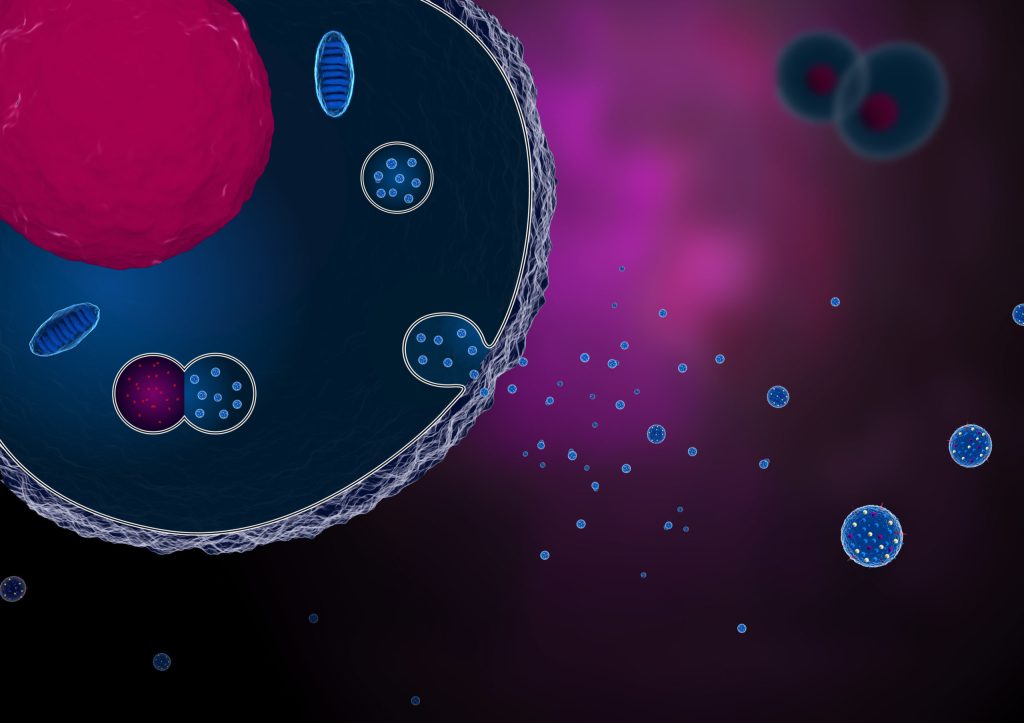
These little guys are hot the aesthetic buzz; but what are they and how do they work? When you look at a cell, all have an intracellular structure called an endosome (meaning that the vesicle is inside the cell). These tiny compartments contain smaller nanoparticulate containers measuring 20-100 nanometers – smaller than the diameter of the human hair. Initially, these were considered to be the ‘trash cans’ of the cell, but now we know that these endosomal particles contain valuable cell signaling biomarkers such as cytokines, chemokines, mRNA, miRNA, and genetic messengers. Their job is to influence neighboring cells to change their behavior.
Exosomes are formed when these endosomes fuse with the plasma membrane of the outer cell wall. A gap in the cell wall is created, and the tiny particles are released into extracellular fluid (ECF). These newly extracellular vesicles were initially associated (a little over 30 years ago) with cell to cell signaling. More recently, they are exploding onto the aesthetic scene as the better-than-stem-cell alternative as stem cells have the potential to become a variety of things ‘at will’ whereas exosomes can be programmed to be more specific and targeted. They are lipid vesicles that shuttle various proteins and genetic informatics between cells (including distant cells – they don’t need direct cell to cell contact!). Messages from exosomes can include rapid healing sequences, tissue repair promoters, and reparative biomarkers that improve tissue quality. Interestingly, about 91% of the effects of stem cells are transmitted in exosomes through a process known as paracrine cell signaling.
So exosomes or stem cells? Stem cells are unprogrammed, transformative cells that encourage regeneration in damaged or diminished tissues. Dr. Duncan frequently combines autologous stem cells into her fat grafting procedures as a way to brighten the skin, remove lining and creasing from underneath, and ensure optimal graft take. Exosomes are naturally present messengers for stem cells that encourage unhealthy cells to begin improving. According to Scientific Reports Journal, “exosome secreted by human adipose mesenchymal stem cells promote scarless cutaneous repair by regulating extracellular matrix” remodeling. The human adipose mesenchymal stem cells are what Dr. Duncan targets when refining fat for fat grafting, and supplement grafted fat with extracted stem cells.
However, not all patients want something as invasive as fat grafting in order to obtain autologous stem cells or exosomes. Currently about 15% of people wanting to improve their appearance choose surgery while the other 85% opt for minimally or noninvasive options. The logic is simple. No one will choose a procedure that creates a significant temporary deformity unless the payoff (8 to 10 years’ worth of improvement) is guaranteed. Instead of destructive procedures, most are interested in restoration of their own existing tissue. What does the field look like for those patients? Stem cell serums from cryopreserved human umbilical cord MSCs are entering the market (check into InfiniViveMD Stem Cell Serum) and lab-grown exosomes (see Benev products) are also becoming available. Exosomes are cultured from stem cells in conditioned media. They are not FDA regulated if applied topically, but they are not FDA-approved for injection.
At PSA, we use exosomes primarily to accelerate healing following a resurfacing treatment such as Neogen or Erbium laser. Stem cell and exosome facials are also available at Dr. Duncan’s office here in Fort Collins; give us a call to see how these non-invasive modalities might glow up your game!
Wang, Lu, et al. “Author Correction: Exosomes Secreted by Human Adipose Mesenchymal Stem Cells Promote Scarless Cutaneous Repair by Regulating Extracellular Matrix Remodelling.” Scientific Reports, vol. 8, no. 1, Jan. 2018, doi:10.1038/s41598-018-24991-y.





